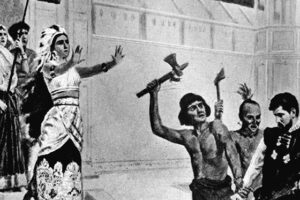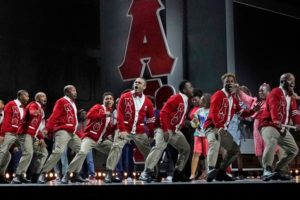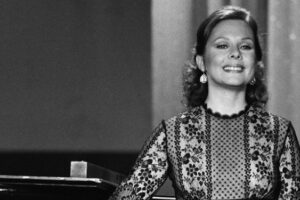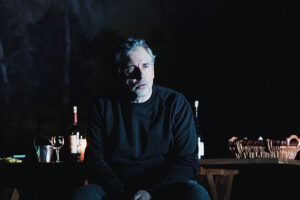

Director Francesca Zambello gives us a quite traditional production, yet one suffused with theatrical energy. Zambello wisely trusts her material, knowing that this work does not require updating or resetting to feel relevant.
And what material it is! Combining the talents of four great names of the American theater—Leonard Bernstein (music), Arthur Laurents (book), Jerome Robbins (direction and choreography) and a young Stephen Sondheim (lyrics)—West Side Story is a feast of glorious music ranging in style from jazz to romance to the almost operatic.
It’s a moving story based on Shakespeare’s Romeo and Juliet with rival gangs (the “American” Jets vs. the newly arrived Puerto Rican Sharks) battling for turf on New York’s Upper West Side, and spectacular dancing from contemporary to balletic. It’s still amazing to me that the show did not win the Best Musical Tony Award (that went to The Music Man), possibly because WSS was the first Broadway musical to feature a tragic ending.
The Lyric Opera production tells the story of the ill-fated passion between Tony and Maria very well indeed, surrounded by some of the finest theatre dancing this reviewer has ever seen. Robbins’ choreography, here reproduced brilliantly by Julio Monge and realized by a remarkable group of dancer/singer/actors, is breathtaking to behold.
The sheer physical stamina required of these performers is jaw-dropping. The dancing is vital to convey the gritty, ugly world of the streets of Manhattan, and it provides a vivid narrative framework for the principals.
At Lyric, we have Corey Cott as Tony, brimming with youthful innocence, an ardent lover torn between loyalty to love and loyalty to friends. Cott has a beautiful, plaintive voice and, despite a couple of flat notes early on, gives a confident and moving performance.
But the breakout star here is Mikaela Bennett as Maria, her shimmering soprano perfectly suited to this music, moving from bubbly exuberance to passion to tragedy without missing a step. This pair makes their improbable love-at-first-sight meeting in The Dance at the Gym utterly believable.
They are surrounded by a supporting cast equally fine, especially Manuel Stark Santos’ menacing Bernardo and Brett Thiele’s determined but optimistic Riff.
Amanda Castro is a vibrant and sexy Anita who sings and dances with great style and wit. Brent Tuomi as Schrank and Jerry Kernion as Officer Krupke avoid the trap of buffoonery and are starkly effective.
All of the Jets and Sharks and their female counterparts give committed and grounded performances, though I think there was a bit of “pushing” for loudness and energy, probably due to understandable opening night jitters.
And what a pleasure to hear this music played by the wonderful Lyric Opera orchestra, conducted with style and attention to detail by James Lowe.
For 60 years, audiences have thrilled to the melodies of “Tonight”, “Maria”, the delightful “America, “and the agonizingly beautiful “Somewhere.” These songs are just as appealing now as when the idea for this musical first occurred to Jerome Robbins in 1949, when he appealed to Bernstein to do a contemporary Romeo and Julietas a conflict between Jews and Irish Catholics on New York’s Lower East Side (the original title was East Side Story).
Six years later, the idea had evolved into its current situation of American vs. Puerto Rican gangs and moved north and west.
The action takes place on a stunning set by Peter J. Davison, using moving chain link fence pieces and a realistic tenement balcony. Less successful was Maria’s second floor bedroom that felt remote from the main action. Here, the usually exciting duet “A Boy Like That/I Have a Love” lost its emotional punch because it was just too far away, and the blocking caused the actors to upstage themselves.
The colorful and character-expressive costumes by Jessica Jahn worked very well with one exception: Ms. Bennett was not well served by the skin-tight leggings in her first scene. Mark McCullough’s creative and stark lighting helped delineate the grimy streets and claustrophobic spaces.
Zambello directed with a clarity of purpose and pulled every emotional nuance from the many crowded scenes. It is rare to see a production of this size and scope held together as such a cohesive whole. And Zambello’s final touch was the most effective. Most productions of West Side Story end with the Sharks and Jets coming together to move Tony’s body offstage.
Here, we end with a tableau: Maria weeping over Tony’s body while all the Sharks and Jets rise and turn to face the audience, putting the responsibility for the tragedy on us all. The effect was chilling.
Lyric Opera’s 2020 musical presentation will be 42nd Street. It will be very difficult to top this rich and emotionally potent West Side Story.
Photo: Todd Rosenberg























Comments